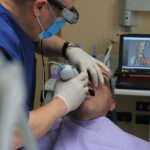
The use of digitally-assisted methods for dental treatment is becoming increasingly popular. Fixed prosthodontics benefit from these new technologies with CAD-CAM systems and intra-oral scanning (IOS) such as CEREC systems offering the chance to produce a crown in a single visit, from impression to fit. Benefits of such a technique for patients include for example a reduction of appointments, less invasive impression techniques, reduced waiting time without restoration or provisional restoration.
The aim of this systematic review was to evaluate the digital impression time both for regular and immediate comparing with the conventional impression time for single implant crowns. Secondary outcomes focused on time efficiency, patient preference and adjustment time.
Methods
Searches were conducted in the Medline-PubMed, Embase and Cochrane Library electronic databases. No language restrictions were applied and articles published up to June 19, 2019 were included. Eligibility criteria were based on title and abstract screening. Inclusion criteria included title mentioning; single implant crowns, clinical trials or digital and conventional workflows. Exclusion criteria were based on article swhich did not consider one of the following aspects; patient preference, time efficiency, adjustment time, impression work time, studies containing the same samples (only most recent one considered), single implant crowns, clinical trials, digital/conventional workflow. Two reviewers independently selected studies, assessed quality and extracted data. A third reviewer was consulted in case of disagreement.
Results
- 1,335 studies were retrieved across the initial database search. Following removal of duplicates and implementation of the inclusion and exclusion criteria, 10 studies were included for qualitative analysis (7 RCTs and 3 observational studies) while 7 studies were included for quantitative analysis.
- Among the 10 studies the total number of patients and single implant crowns were 214 and 278 respectively.
- 7 studies analysed impression time between groups. All of them reported a shorter digital impression time compared to conventional impression. (p < .05)
- 7 studies analysed patient preference between groups. All of them reported a preference for digital impression compared to conventional impression (p<.05)
- 5 studies analysed clinical adjustment time between groups. 2 studies demonstrated that clinical adjustment time was significantly shorter with digital technique (p= .0002 and p< .001) while 1 study showed that this was significantly longer for digital group (p=0.0013). Two studies could not demonstrate any significant change between the two techniques (p= .5 and p= .256)
- Finally, 4 studies analysed time efficiency between groups with all studies showing digital technique being significantly faster than conventional technique (p< .05) apart from one study where final crown delivery was not significantly faster with digital technique (p= .5)
- Meta-analysis revealed that the reduction in the time required for the digital group was statistically significant (MD: 8.22 mins) both for immediate and regular digital impression when compared to conventional technique.
- No statistically significant heterogeneity was found for immediate digital impression when compared to conventional (I2 =0%) while heterogeneity was high for both regular digital and main digital when compared to conventional (I2=98%)
- 5 of 7 studies were at low risk of bias for randomized control trials while 3 observational studies were at low risk and showed high methodological quality.
Conclusions
The authors concluded:
Conventional and digital impressions are effective, but both immediate and regular digital impressions take less time than a conventional impression for single implant crowns. However, this time difference may be not clinically relevant.
Patients showed preference for digital impression over the conventional technique.
Digital workflow seemed to be more time-efficient than conventional for single implant crowns but the main difference between digital and conventional workflow is in the fabrication time, and not during impression taking or crown delivery.
Comments
Despite the fact that the authors have limited their search to three databases, they were able to identify relevant studies in order to address their question and did not apply any language restrictions. Two calibrated authors used the Newcastle-Ottawa scale (NOS) to assess bias. Most studies included showed low risk of bias and high methodological quality. Furthermore, studies included a fair sample of patients with 214 individuals and 278 crowns.
The results highlight multiple advantages of digital workflow in terms of impression time, patient preference and time efficiency. Digital impressions recorded at time of surgery can reduce the number of appointments required for completion of treatment. Some limitations were noted regarding heterogeneity of main digital impression time compared to conventional. This was due to one study assessing impressions at two different time through treatment. (one for temporary crown and one for final crown). Further high-quality evidence using similar methods and designs in wider randomised control trials would be necessary in order to confirm the clear advantage of digital workflow. Furthermore, the authors highlight the need for long-term follow-up to report survival rates using those new technologies.
Links
Primary paper
de Oliveira NRC, Pigozzo MN, Sesma N, Laganá DC. Clinical efficiency and patient preference of digital and conventional workflow for single implant crowns using immediate and regular digital impression: A meta-analysis. Clin Oral Implants Res. 2020 Aug;31(8):669-686. doi: 10.1111/clr.13604. Epub 2020 May 28. PMID: 32329094.
Picture Credits
Photo by Quang Tri NGUYEN on Unsplash
